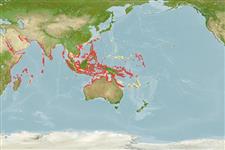Environment: milieu / climate zone / depth range / distribution range
Ecologia
marino associati a barriera corallina; distribuzione batimetrica 3 - 30 m (Ref. 90102), usually 5 - 20 m (Ref. 27115). Tropical; 22°C - 30°C (Ref. 27115); 30°N - 22°S, 32°E - 175°E
Indo-West Pacific: from Seychelles to Fiji; north to Japan, south to New Caledonia.
Size / Peso / Age
Maturity: Lm ? range ? - ? cm
Max length : 8.5 cm SL maschio/sesso non determinato; (Ref. 48637)
Spine dorsali (totale): 7; Raggi dorsali molli (totale): 15-17; Spine anali 1; Raggi anali molli: 15 - 16. This species is distinguished by the following characters: D VI + I,15-17; A I,15-16; pectoral-fin rays 16-17; scales in longitudinal series 49-54, in transverse series 17-18; interorbital wide, 67-90 % of eye diameter; rear margin of upper jaw ending posteriorly slightly behind or at vertical through anterior margin of eye; first two dorsal-fin spines filiform, elongate, remaining progressively shorter, the sixth dorsal-fin spine almost reaches the origin of the second dorsal; small ctenoid scales on body, cycloid at axil of pectoral fin, nape and entire belly, and in the area between first dorsal fin and pectoral fin; predorsal scales 16-22, scales not reaching to the vertical through the posterior edge of eye, ending at the level of pore G or H'; cheek and opercle naked; scales cover the basal 1/3-1/4 of caudal fin, becoming rapidly smaller and cycloid; prepectoral area with about 4-9 vertical series of fine cycloid scales covering the entire base of the pectoral fin; prepelvic area with cycloid scales, 9-14 in the midventral row; width at anal-fin origin 9.9-10.7% of SL; caudal peduncle depth 75.4-88.9% of its length; head depth 47.3-54.4% of HL; length of 11th second dorsal-fin ray 11.8-14.2% of SL; length of 8th anal-fin ray 13.7-14.9% of SL (Ref. 119548).
Inhabits sheltered bays and inner reefs on fine rubble shaded by large living corals (Ref. 48637). Occurs solitarily, hovering a short distance above sandy bottoms of reef bases. Stomach contents of one specimen comprise of filamentous algae, harpacticoid copepods, ostracods, amphipods, and nematodes (Ref. 9360).
Life cycle and mating behavior
Maturità | Riproduzione | Deposizione | Uova | Fecundity | Larve
Kovačić, M., S.V. Bogorodsky, A.O. Mal and T.J. Alpermann, 2018. Redescription of the genus Koumansetta (Teleostei: Gobiidae), with description of a new species from the Red Sea. Zootaxa 4459(3):453-481. (Ref. 119548)
IUCN Red List Status (Ref. 130435)
Threat to humans
Harmless
Human uses
Acquario: Commerciale
Informazioni ulteriori
Nomi ComuniSinonimiMetabolismoPredatoriEcotossicologiaRiproduzioneMaturitàDeposizioneSpawning aggregationFecundityUovaEgg development
BibliografiaAcquacolturaProfilo di acquacolturaVarietàGeneticaElectrophoresesEreditarietàMalattieElaborazioneNutrientsMass conversion
Strumenti
Special reports
Download XML
Fonti Internet
Estimates based on models
Preferred temperature (Ref.
123201): 24.7 - 29.2, mean 28.4 °C (based on 320 cells).
Phylogenetic diversity index (Ref.
82804): PD
50 = 0.6250 [Uniqueness, from 0.5 = low to 2.0 = high].
Bayesian length-weight: a=0.00708 (0.00333 - 0.01504), b=3.09 (2.92 - 3.26), in cm total length, based on LWR estimates for this (Sub)family-body shape (Ref.
93245).
Trophic level (Ref.
69278): 2.1 ±0.1 se; based on diet studies.
Resilienza (Ref.
120179): Alto, tempo minimo di raddoppiamento della popolazione meno di 15 mesi (Preliminary K or Fecundity.).
Fishing Vulnerability (Ref.
59153): Low vulnerability (10 of 100).
Nutrients (Ref.
124155): Calcium = 162 [70, 326] mg/100g; Iron = 0.867 [0.407, 1.738] mg/100g; Protein = 17.4 [15.4, 19.2] %; Omega3 = 0.0835 [, ] g/100g; Selenium = 26 [12, 64] μg/100g; VitaminA = 114 [24, 529] μg/100g; Zinc = 2.67 [1.65, 4.09] mg/100g (wet weight);
